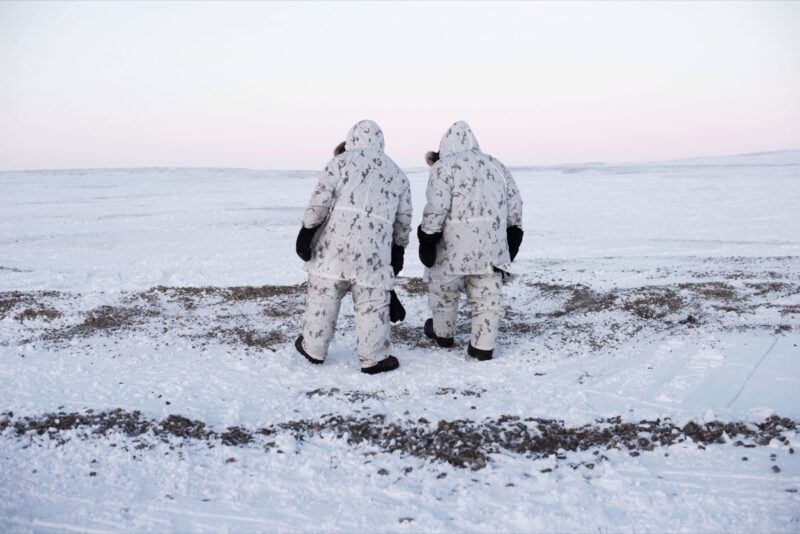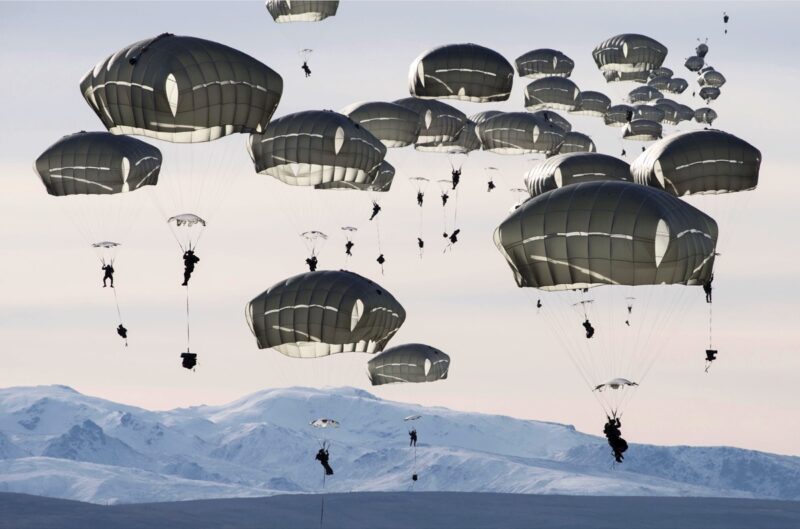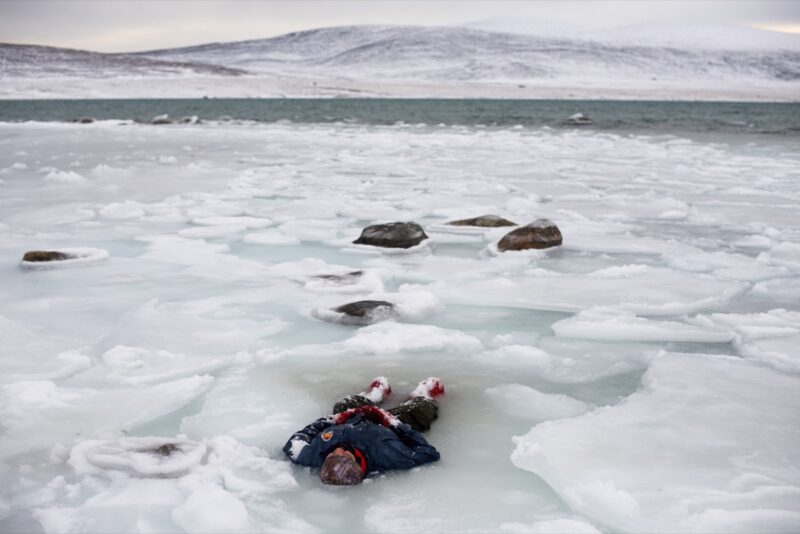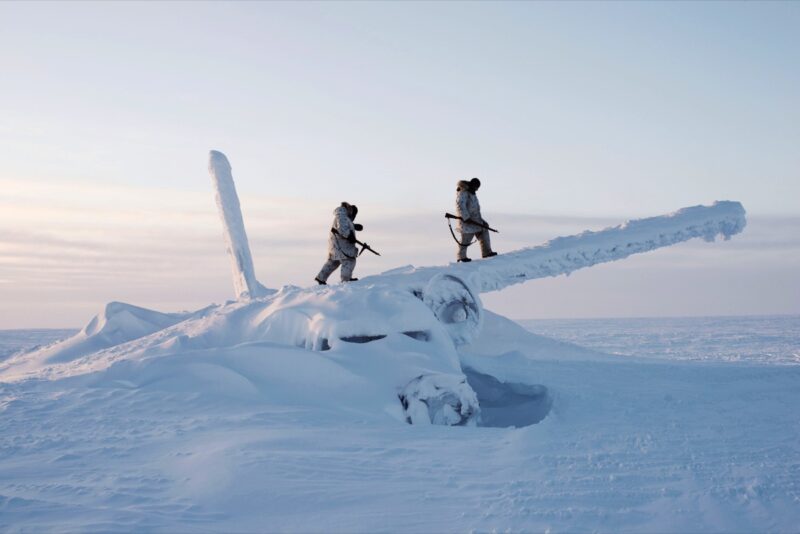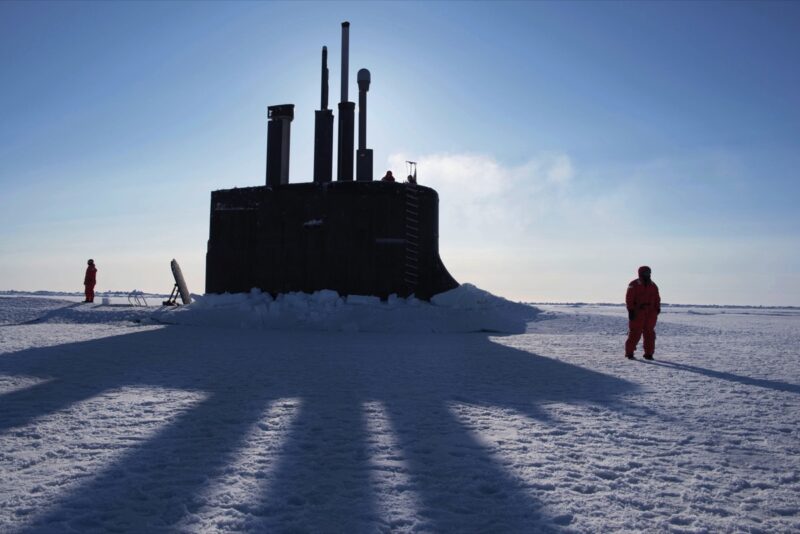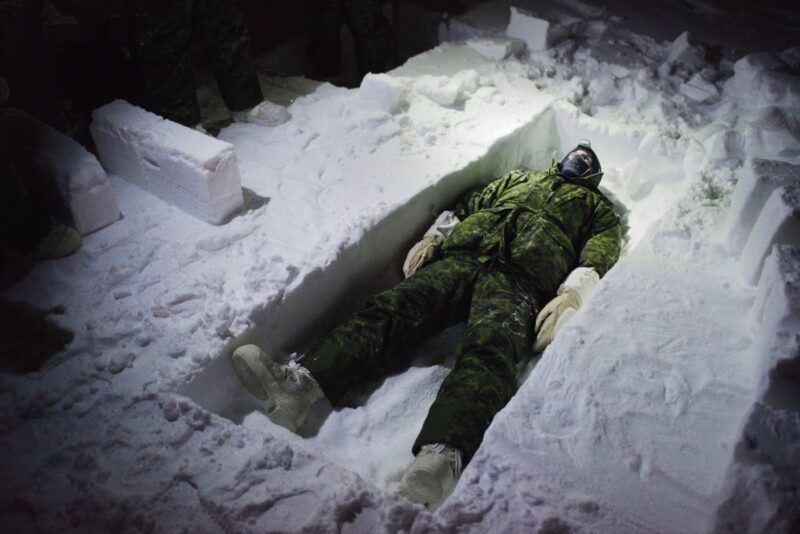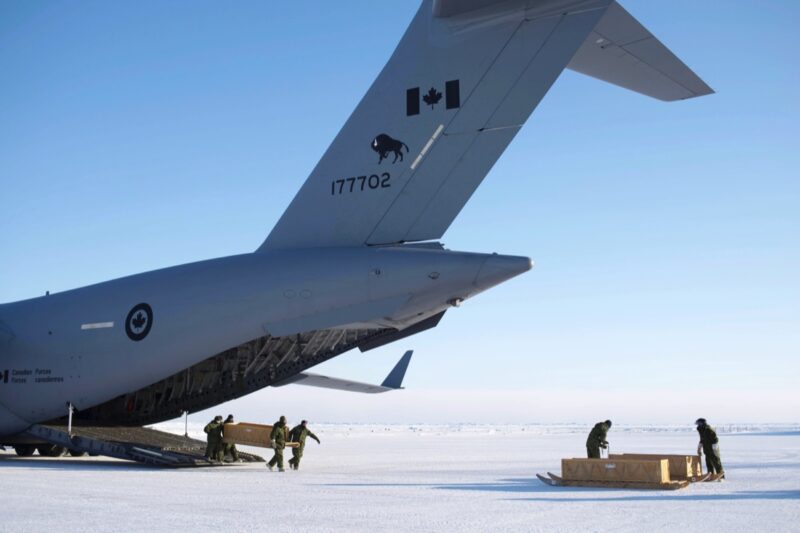The Arctic has long been a site of fascination and promise in the Western imagination. But beneath the intrigue runs a dark shadow. Recall the fever dream of the Franklin Expedition in the nineteenth century, its sea-route fantasy perishing along with its crew. During the Cold War, military infrastructure defended North America from imagined Soviet missiles, though the only real threat was to Indigenous inhabitants – some of whom were transplanted there as human flagpoles – from its toxic remnants, being released now in the thaw. Climate change, the progeny of industrial capitalism’s fossil-fuel orgy, is opening up that frozen land for resource extraction and reviving the old dream of Arctic passage. Salivating investors, and military machines revving up to protect them, have instigated a deadly feedback loop of wealth, weapons, wars, and warming, setting us spinning toward climate catastrophe.
These contradictions and circular dilemmas run through Louie Palu’s photographic project made between 2016 and 2018, titled Distant Early Warning in reference to the acronymic DEW line, a costly and, in the end, useless radar line designed to intercept Soviet attacks on North America. Palu updates our view of that region at a pivotal moment: rather than radically reducing carbon emissions to slow Arctic warming, now occurring four times faster than in the rest of world, intensified militarization is drastically increasing those emissions. Palu records the central characters in this drama: the Inuit people practising the traditional survival skills that have enabled their existence, even as their environment changes, and the massive military presence that exploits that ancient knowledge for geopolitical power.
This latest of Palu’s explorations follows three decades of documentary photographic projects, films, and artworks that similarly focused on sites of conflict, including the war in Afghanistan, the Mexican drug wars, and the Canadian mining industry. In fact, it was a 1993 assignment covering the discovery of diamonds in the Northwest Territories that first took Palu north, initiating an archive that has grown to over two hundred thousand photographs. He’s returned over forty times now and has visited every Arctic country, with the exception of sanctioned Russia: Canada, Finland, Greenland (Denmark), Iceland, Norway, Sweden, and the United States.
The impossibility of surviving without support in these frigid environments demands Palu’s reliance on Indigenous and military infrastructure. His subjects break down into a few categories: the land – vast expanses of ice and snow and, less often, sparse summer tundra; the Inuit people, including the Canadian Rangers, made up especially of indigenous peoples in remote regions who maintain some of their traditional lifestyles, run volunteer search-and-rescue services, and teach survival skills to military personnel; and NATO soldiers undergoing training exercises to prepare for future Arctic warfare.
The rudimentary requirement of documentary photography, before image quality and aesthetic value, is simply being there, which, due to the high risk of perishing in temperatures that can plummet to –60° Celsius, is the greatest challenge. Palu likens the danger to that of an Afghan war zone; here, however, instead of bullets and bombs, it’s the air that can kill you. Frostbite sets in after four minutes, and there are no hospitals to save you.
In addition to the various physical and psychological discomforts, camera equipment is also subject to failure and the limited daylight hours reduce access and image quality. In such inhospitable environments, photographing one scene or event might take days of preparation. Palu’s photograph of a US nuclear submarine during weapons testing is one such instance: a week of diverse travel modes was rewarded by three hours of photography. The effort paid off: the resulting image shows a dark, ominous silhouette protruding through sea ice, with tentacles of shadow leaking out around it suggesting a radar warning symbol.
Production of this ongoing project developed in different stages. At first on his own, then supported by a Guggenheim Fellowship, Palu accumulated images as he worked on various journalistic assignments, including for The Globe and Mail, Bloomberg, and National Geographic. The selection shown here was drawn from Palu’s earliest work, in North America and Greenland. Importantly, he retains full ownership of all his photographs, essential for an artist who sometimes makes creative forays into other formats. For example, a 2019 installation at the Harry Ransom Center for SXSW (Austin, Texas) featured portraits of Inuit, encased in blocks of ice. As the ice melted in the heat, it illustrated the destructive effects of climate change on Arctic peoples.
For his earlier work, Palu preferred to work in black and white, long a convention for documentary photography, which he used to dramatic effect to emphasize shapes, light, and textures in, for example, his miners project, Cage Call (1991–2003). His shift to colour, begun in Afghanistan, continues here. Absent are the warm shades and rich tonal drama from that series, but the near-monochromatic, high-key snow-white and ice-blue landscape, reflecting the thin, killing air, offers greater potential for abstraction. We still get slices of the real world, the prime expectation for documentary photography. But here, surface reality comes dressed in an abstract style that opens up the image for metaphorical meaning.
Palu’s approach to photographing human subjects contributes to that abstract quality. Shown from behind, in silhouette, profile, or shadow, their unidentifiable faces sometimes masked from the cold, they become the universal everyman. Like the Romantic painter Caspar David Friedrich’s pondering figures in desolate landscapes, they stand as empty ciphers, allowing viewers to slip inside and inhabit their imagined experience. One exemplary image shows two figures, their padded camouflage snowsuits blending into the seascape, standing before the horizon, contemplating, we might imagine, an uncertain and liquid future.
Creating the perfect balance of realism and abstraction to express a predetermined meaning can take numerous attempts. Such was the case with Palu’s exquisite image of paratroopers at an Alaskan training base. The soldiers, suspended from flimsy parachutes, floating and falling gently through a pale-blue sky against a majestic mountain range, seem tiny and inconsequential. Yet, armies and industry alike, in a short-sighted desire for personal gain, imagine their conquest and control over a vast and formidable nature.
Palu’s photographs of soldiers learning to cut snow blocks for igloos similarly exemplify his use of abstraction to deliver readings beyond the documentary fact. In one image, a soldier lies rigid, isolated inside a coffin-shaped opening in the snow. Suggesting the military’s dark presence in the Arctic and its exploitation of Inuit knowledge, the picture also points to our collective future, doomed by this very activity.
A prominent theme for Palu is the centrality of Indigenous knowledge that makes life in the Arctic possible, and upon which Southerners rely so heavily. He frequently uses the terms “technology” and “science” – words usually reserved for Western inventions – to describe Inuit practices and materials. His compositionally spare photograph of two Rangers – back to back, in profile, faceless – foregrounds one of these essential technologies, the parka, its fabric made from modern fabrics rather than animal skins. Another striking image juxtaposes Western and Arctic technology: a military cargo aircraft unloads komatiks (Inuit sleds). Now made from a colonial material, wood, rather than the original animal hide, its design still makes it essential for transporting goods. A post-apocalyptic image showing two figures striding across the wing of a snow-covered airplane wreck, a not-uncommon sight, shows the impotent hubris of Western technology within omnipotent nature.
On the surface, this mix of images – either quotidian, illustrative, or striking in their aesthetic drama – shows the fantasy of geopolitical and environmental control and the foot soldiers earnestly preparing to secure Northern wealth through war. But a subtle yet undeniable swathe of darkness offsets that dangerous dream, exposing the destruction in its wake. The duality that Palu creates through his incorporation of the real with the metaphorical is present in his project’s title, Distant Early Warning: on a literal level it refers to the historic, sabre-rattling DEW line; on a rhetorical level, it cautions that our self-inflicted demise may be no longer distant but imminent. That it is no longer early, but too late.

